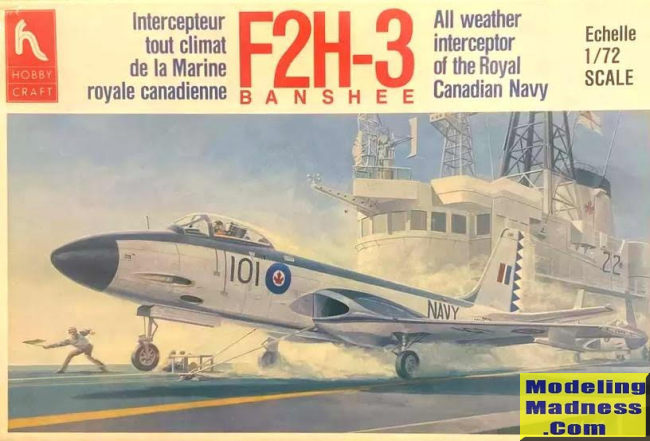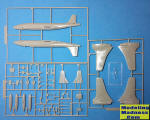
Hobbycraft 1/72 F2H-3 Banshee
| KIT #: | HC 1397 |
| PRICE: | $10.00 when new |
| DECALS: | Two options |
| REVIEWER: | Spiros Pendedekas |
| NOTES: | Initial (1987) release |

| HISTORY |
With its name derived from Irish mythology, the McDonnell F2H Banshee was a single-seat, twin-engine carrier-based jet fighter aircraft, operated by the United States Navy and United States Marine Corps. It was also the only jet-powered fighter to ever be deployed by the Royal Canadian Navy. The earlier variants were mainly used operationally during the Korean War.
| THE KIT |
 Hobbycraft
came in 1987 with their 1/72 Banshee, reissuing it a couple more times till
Academy acquired their molds and reissued it in 2001 and 2017. Prior to it, the
other option was the 1980 Airfix offering and by the looks of things the
Hobbycraft kit can be essentially considered an upgraded version of the Airfix
with engraved panel lines.
Hobbycraft
came in 1987 with their 1/72 Banshee, reissuing it a couple more times till
Academy acquired their molds and reissued it in 2001 and 2017. Prior to it, the
other option was the 1980 Airfix offering and by the looks of things the
Hobbycraft kit can be essentially considered an upgraded version of the Airfix
with engraved panel lines.
The specific kit is the original 1987 release and was bought in 2004 from a (now
sadly closed) toy/hobby shop in my hometown at a fairly low price. It comes in a
medium sized good quality top opening box featuring an attractive box art of a
Canadian Navy machine being catapulted from HMCS Bonaventure.
Upon opening the box, I was greeted with 47 light gray styrene parts arranged in
three sprues. Of them, one sprue holds the fuselage halves, the other holds the
wing halves and the third holds everything else. Molding is sharp and almost
flash free. Panel lines are engraved and quite well done and general shapes of
parts look correct to my inexperienced Banshee eye (leaving the rest to the
Experten).
Cockpit is reasonably appointed, with the instrument panel and side consoles
featuring believable raised instruments. The seat looks fair and would
definitely benefit from some extra detailing (or replaced by a resin one). The
engine inlets and exhausts are also adequately represented, including the
distinctive inlet surrounds. While the gun openings at the fuselage sides are
well done, their inner emptiness is apparent from quite a few angles, so you may
wish to blank their innards before closing the fuselage halves.
The landing gear parts look sufficient, but the same cannot be said for the
bays, all three of which are too shallow and will look unrealistic when the
model is viewed from below. Possible improvements there will require an amount
of effort, as the builder, apart from cutting out the bay walls and deepening
them, will have to somehow lengthen the gear struts or search for suitable
aftermarket. The nose landing gear strut is too short, resulting in an equally
unrealistic nose down posture, but this can be remedied quite easily by adding
an extension styrene rod. Finally, four wing pylons and an equal amount of
rockets are provided as ordnance, together with a pair of good looking tip
tanks.
The sole transparency is quite nicely molded and crystal clear. No gunsight is
provided, so you may wish to add a simplistic one for better looks. Instructions
are typical Hobbycraft, coming in the form of a three-folded pamphlet,
containing a short history of the type, with the construction spread in 8 clear
and concise steps. No internal color callouts are given, but you may consult the
instructions from the Academy recent reboxings or from other more recent Banshee
kits.
 Two schemes
are provided, a USN gray over white and a Canadian dark gray over light gray.
Though the almost 40 years old decals seem still usable, the red is
off-registered, this being quite obvious at both the US and Canadian roundels.
Two schemes
are provided, a USN gray over white and a Canadian dark gray over light gray.
Though the almost 40 years old decals seem still usable, the red is
off-registered, this being quite obvious at both the US and Canadian roundels.
Instructions want you to first assemble the cockpit and trap it between the
fuselage halves. 10-15 grams of weight are also to be trapped within the nose,
to avoid tail sitting (I would opt for 15 grams - better safe than sorry). The
wings are then assembled and attached, followed by the tail planes (they are
mounted at a slightly upwards angle), landing gear, external ordnance and tip
tanks, ending a seemingly very simple build.
| CONCLUSIONS |
If you want a F2H-3 Banshee, this is still your only option (Sword makes
the -2 version, together with Airfix, from which the Hobbycraft emerged). That
said, the Hobbycraft is a solid kit, offering a decent representation of the
F2H-3, having its strong points (sharp molding, well done engraved panel lines,
looks accurate) and lacking at areas like the too shallow wheel wells and the
off-registered decals (the newer reboxings have better decals), with the detail
at key areas (like the cockpit, engine and landing gear parts) being acceptable,
making it overall a kit worth tackling.
Happy Modeling!
June 2024
Copyright ModelingMadness.com. All rights reserved. No reproduction in part or in whole without express permission.
If you would like your product reviewed fairly and fairly quickly, please contact the editor or see other details in the Note to Contributors.